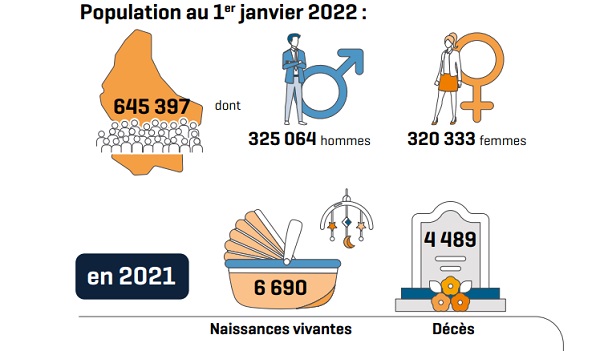 Credit: STATEC
Credit: STATEC
Luxembourg's national statistical institute, STATEC, has announced that as of 1 January 2022, the population of the Grand Duchy had reached 645,397 - an increase of 1.68% compared to the previous year.
After a demographic slowdown in 2020, Luxembourg's population increased by 10,667 people during the year 2021, bringing the total number of inhabitants to 645,397 as of 1 January 2022; this number stood at 634,730 as of 1 January 2021. This increase in the population, mainly due to net immigration, is thus returning to levels close to those observed before the onset of the COVID-19 health crisis.
In 2021, a natural balance (i.e. the difference between the numbers of births and deaths) of 2,201 people and a migratory balance (or net migration, i.e. the difference between immigration and emigration) of 9,376 people were observed. The share of international migration in population growth was therefore 87.9% in 2021.
Between 1 January 2021 and 1 January 2022, Luxembourg's population increased by 1.68%. This increase is a little less than that observed before the pandemic (the rate fluctuated between 2% and 2.5%) but is higher than that observed in 2020 (1.4%).
As of 1 January 2022, the average age of the population was 40.4 years for women and 39.0 years for men. Foreign residents were significantly younger than Luxembourgers. The average age for Luxembourgish women was 42.4 years compared to 38.1 years for foreign women. For Luxembourgish men, the average age was 40.0 years whilst that of foreign men was 38.0 years.
Increase in births
The number of births increased from 6,549 in 2020 to 6,690 in 2021 (up 2.1%). This increase is due to both the higher number of births of children of foreign nationality (up 4.3% compared to 2020) and the number of Luxembourgish newborns (up 2.9%). Women in Luxembourg gave birth to an average of 1.38 children in 2021 compared to 1.37 children in 2020.
Decrease in deaths
In 2021, the number of deaths stood at 4,489 - a decrease of 2.6% compared to 2020 (4,609 deaths). Slightly more men (51.1%) than women (48.9%) died. Luxembourg nationals accounted for 75.7% of deaths, while deaths of foreign nationality were much rarer (24.3%). This difference is largely explained by the age structure of the population, which is younger for foreigners. The average age of all the deceased was 77.6 years (80.7 years for women and 74.7 years for men). Life expectancy at birth hardly changed, standing at 84.8 years for women and 80.3 years for men. People who died with COVID-19 represented 9.0% of all deaths in 2021 compared to 11.0% in 2020.
Increasingly diversified immigration
International migratory flows, which had been impacted by the health crisis in 2020, are on the rise again. In 2021, Luxembourg witnessed 25,335 international arrivals and 15,959 departures. Portuguese nationals (3,885 immigrants, or 12.8%) were most widely represented in Luxembourg last year, ahead of French (3,590 or 9.6%) and Italian (1,909 or 8.9%) nationals. These groups were followed by Spanish, Indian, Romanian, Syrian, Brazilian, German and Greek nationals. STATEC noted that the number of Ukrainian nationals living in Luxembourg as of 1 January 2022 was 1,075 - a figure that has been constantly increasing over the years (up 6.8% compared to 1 January 2021) and which is expected to further increase throughout the year in the context of the Russia-Ukraine war.
Luxembourg nationals (3,063 emigrants) made up the largest group of emigrants from the Grand Duchy, followed by Portuguese (3,055) and French (2,394) nationals.
Share of Luxembourgers remains stable
Between 2020 and 2021, the number of naturalisations fell once again from 9,387 to 6,801 (down 27.5%). This decrease is explained by the fact that the procedure of reclaiming Luxembourg nationality based on descent from an ancestor who had the Luxembourgish nationality on 1 January 1900 will soon expire. In July 2021, the deadline for completing the formality of the nationality reclamation declaration was extended until 31 December 2022. Due to travel restrictions linked to the COVID-19 pandemic, many candidates residing abroad were materially unable to organise their trip to the Grand Duchy to complete this formality in person before the civil registrar. These were mainly applicants from Brazil and the United States (US).
Among these naturalisations, 27.5% were granted to people who do not have their residence in Luxembourg. This group included 1,033 people who live in France (55.3% of non-residents), 844 in Belgium (26.7%) and 139 in the US (5.1%).
The share of Luxembourgers in the population remained stable at 52.9% as of 1 January 2022.
Increase in marriages, decrease in divorces
While a decrease in marriages was observed in 2020 in light of COVID-19 restrictions, the number of marriages began rising again in 2021: this figure rose by 7.9% over one year to 1,945. This included 36 same-sex marriages, including eleven marriages between two men and 25 between two women.
Following new legal provisions (a 2018 law establishing the family court judge), the number of divorces had increased sharply in 2019. However, this figure decreased by 3.2% between 2020 and 2021, standing at 1,400 as of 1 January 2022.








